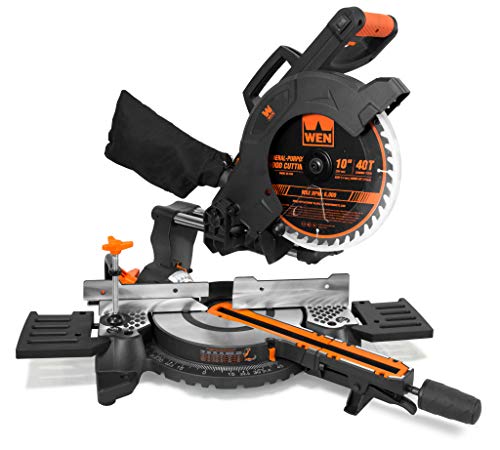The maximum material thickness that can be cut with a miter saw depends on the size and type of saw. Generally, a 10-inch miter saw can cut up to 6 inches in thickness, while a 12-inch saw can cut up to 8 inches.
Are you looking for the maximum material thickness you can cut with a miter saw? You’ve come to the right place! Cutting thick materials with a miter saw can be challenging and require the right saw for the job. In this blog, we’ll explore the different types of miter saws, the factors that affect the maximum thickness that can be cut, and the techniques and safety precautions to keep in mind when cutting thick materials with a miter saw. We’ll also discuss maintenance and cleaning steps to keep your saw in top condition.
Types of miter saws
When it comes to miter saws, there are several types available. Each one is designed for a specific purpose, so which one you should choose depends on the type of projects you plan to do. Here are some of the most common types of miter saws and the maximum material thickness that they can cut.
The most basic type of miter saw is the compound miter saw. These are good for basic projects and can cut through wood or plastic up to 2.5 inches thick. They are also relatively inexpensive, making them a great option for those just getting started with woodworking.
The sliding miter saw is a more advanced version of the compound miter saw. It can cut through materials that are up to 4 inches thick. It also has a sliding mechanism which allows it to cut wider boards. This makes it a great choice for more advanced projects, such as trimming doors or making custom furniture.
The last type is the radial arm saw, which is the most powerful type of miter saw. This can cut through materials up to 6 inches thick. It is also the most expensive type of miter saw, but it is worth the investment for those who do a lot of heavy-duty projects.
No matter which type of miter saw you choose, make sure to measure the material you plan to cut before you buy a saw. Knowing the maximum material thickness that can be cut by each type of miter saw will help you make the right decision.
Factors affecting maximum thickness
When it comes to the maximum material thickness that can be cut with a miter saw, there are several factors that affect how thick the material can be. First, the power of the saw is an important factor – the higher the power, the thicker the material that can be cut. Secondly, the size of the blade can also affect the maximum thickness. If you have a larger blade, it can cut through thicker material than a smaller one.
The type of material being cut can also be a factor. Some materials are harder to cut than others due to their density. For example, a miter saw may be able to cut a thinner piece of softwood, but it won’t be able to cut a thicker piece of hardwood. Similarly, some metals may be easier to cut than others.
Finally, the speed of the saw can also have an effect on the maximum thickness of the material that can be cut. If the saw is spinning too quickly, it may not be able to cut through thicker pieces of material. However, if the saw is spinning slowly, it may be able to cut through thicker pieces.
Overall, the maximum material thickness that can be cut with a miter saw depends on several factors, including power, blade size, type of material, and speed. By taking all of these factors into consideration, you can ensure that you are choosing a saw that can handle the material you need to cut.
Saws capable of cutting thick materials
When it comes to cutting thick materials, a miter saw is a great tool to have in your arsenal. Not only do miter saws have a wide range of cutting angles, they can also cut through materials up to 2 inches thick. Some of the materials that can be cut with a miter saw include wood, plywood, aluminum, and plastic.
In addition to the materials listed above, a miter saw can also cut through thicker materials such as steel, brass, and other metals. The key to cutting thick materials with a miter saw is to have the right blades. A standard miter saw blade can easily cut through materials up to 1 inch thick, but for materials that are thicker than 1 inch, you will need to look for a blade that is specifically designed for thicker materials.
Most miter saws come with a manual that will provide you with all the information you need regarding the types of blades needed for the job. It is important to read the manual thoroughly before attempting to cut any thick material with your miter saw. This will help ensure that you are using the right blade for the job, which will result in a cleaner, more precise cut.
For those who are looking to cut through thicker materials, a miter saw is an excellent tool. It is capable of cutting through materials up to 2 inches thick, and with the right blades, it can even cut through thicker materials. When it comes to cutting thick materials, a miter saw is a great choice.
Techniques for cutting thick materials
Using a miter saw to cut thick materials can be a daunting task. But with the right techniques, any material thickness can be easily and safely cut. Here are a few tips on how to get the job done:
First, make sure the material is firmly secured. If the material is thick, you may need to use additional clamps to hold it in place. This will help ensure a cleaner, straighter cut.
Second, use a blade specifically designed for thick materials. Depending on the thickness of the material, you may need a blade with more teeth or a higher tooth count, as this can help with the cutting speed and accuracy.
Third, use a slow and steady motion when cutting. If you’re cutting something extremely thick, you may need to make multiple passes with a lower speed. This will help ensure a clean and accurate cut.
Finally, be sure to use the correct safety equipment, such as eye protection, gloves, and a face mask. This is especially important when cutting thick materials, as the particles created by the saw can be dangerous.
By following these tips, you’ll be able to safely and easily cut through any material thickness with your miter saw.
Safety precautions
When using a miter saw, it is important to take the necessary safety precautions. First and foremost, always wear protective gear, such as safety glasses and gloves. Make sure to keep your fingers and hands away from the blade, and never reach over it. Additionally, never operate the saw without the blade guard in place. Making sure that the blade guard is in place helps to protect you from any flying debris and dust.
Before making a cut, be sure to inspect the blade and make sure it is in good condition. If you notice any dull spots or rust, replace the blade. Also, ensure that the miter saw is firmly secured to a workbench or surface. This will help reduce the risk of the saw moving or tipping when making a cut.
Lastly, be mindful of your own energy levels. Make sure to take regular breaks and keep yourself hydrated. This will help prevent any accidents due to fatigue. By following these simple safety guidelines, you can enjoy your time using a miter saw without any worries.
Maintenance and cleaning
Keeping your miter saw in top condition is crucial for achieving quality cuts. Regular maintenance and cleaning of your miter saw should be part of your routine. To ensure your saw’s optimal performance, you should check for any loose parts, dull blades, and damages. Make sure to unplug the saw before performing any maintenance or cleaning.
When it comes to cleaning your miter saw, you should use a vacuum cleaner to remove any dust and debris from the saw’s base and blade guard. To make sure you get into all the nooks and crannies, use a brush or compressed air to remove stubborn dust particles. You should also clean off the miter saw’s table and fence with a damp cloth.
To sharpen the blades of your miter saw, you should first remove the blade and sharpen it with a sharpening stone or file. Make sure to wear gloves when handling the blade, as the sharp edges can be dangerous. Once the blade is sharpened, you should also lubricate it with oil. Finally, reinstall the blade, tighten the screws and bolts, and check for any wobbling.
By taking the time to clean and maintain your miter saw, you can be sure that it will stay in good condition for many years to come. After all, a well-maintained saw will produce quality cuts and extend its lifespan.

Frequently Asked Questions
How thick of materials can i cut with a miter saw?
With a miter saw, you can typically cut through material up to 6 inches thick. However, the exact maximum thickness may vary depending on the miter saw’s blade size and power. If you are looking to cut thicker materials, make sure you look for a saw with a larger blade and more power.
What is the maximum material thickness that can be cut with a miter saw?
The maximum material thickness that can be cut with a miter saw depends on the type and size of the blade, but typically ranges from 3/4″ to 12″. The size and type of the blade should always be considered before attempting to cut thicker material.
What types of miter saws can cut the thickest materials?
The type of miter saw that can cut the thickest materials is the sliding miter saw. This saw is designed to handle the largest cuts and can easily handle materials up to 12 inches thick. For even thicker materials, large industrial miter saws are available, which can provide even more cutting power.
What safety precautions should i take when cutting thick materials with a miter saw?
When cutting thick materials with a miter saw, it’s important to wear safety gear such as safety glasses, dust masks, and hearing protection. Make sure the material is firmly held in place and secure before cutting. Always use a sharp blade and keep your hands away from the blade. It’s also advisable to unplug the saw when making adjustments or changing blades.
Conclusion
Overall, a miter saw can be a great tool for making accurately angled cuts into a variety of materials. The maximum material thickness that can be cut with a miter saw depends on the type of saw that you have. It can range from 3/4 inches on smaller saws, to 12 inches on larger saws. Knowing the maximum material thickness your miter saw can handle is important to ensure that you are making the most accurate and safe cuts possible. As with any power tool, it’s always important to use safety precautions when working with a miter saw. With the right precautions and knowledge, you can get the most use out of your miter saw and create great projects along the way.
